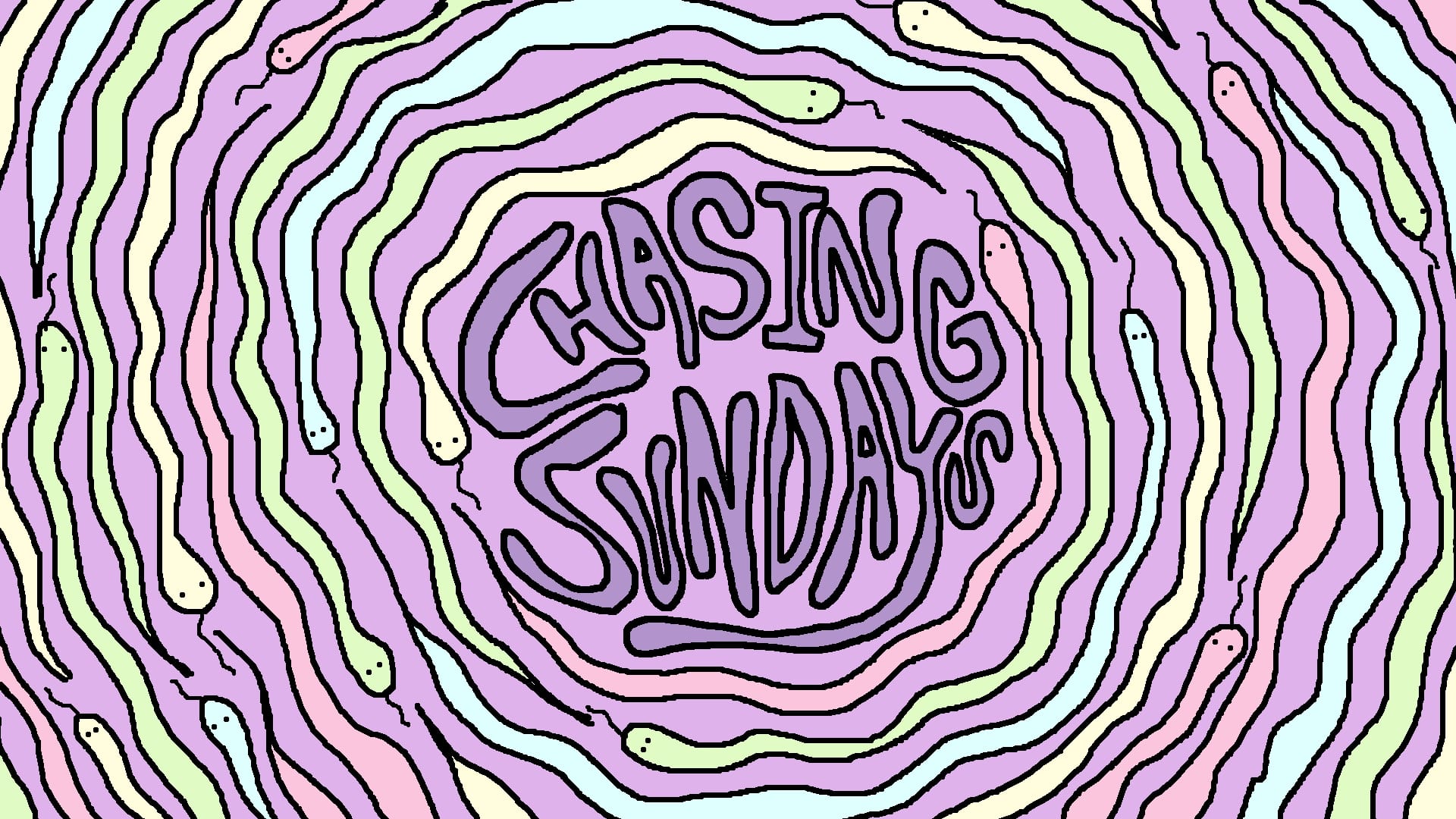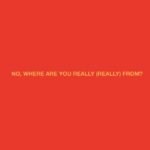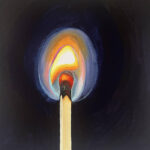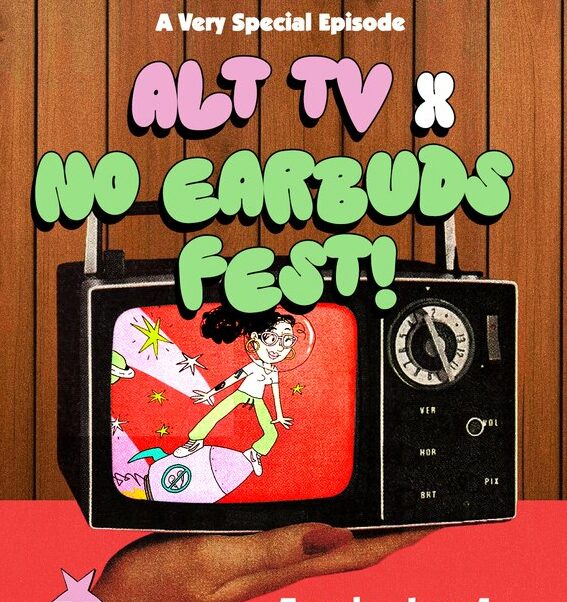Chasing Sundays: September 2020
Posted: by The Alt Editing Staff

Chasing Sundays is Eli Enis’ bi-monthly deep-dive into vast the world of shoegaze. From its celestial pop outer-edges to its overwhelmingly heavy inner-core, these are some of the most valuable inclusions to the global shoegaze canon.
The other day on Twitter, a few of my music journalist colleagues were chatting about the new Hum album, which surprise-dropped in the time since the last Chasing Sundays column ran. Inlet was their first album in 22 years, and much like recent-ish reunion records from the likes of My Bloody Valentine, American Football, and to a lesser extent Duster, it was one of those “Holy fuck, ‘x’ seminal ‘90s indie band is back???” moments that very few people could have anticipated. On top of the novelty and general excitement for their return, the record really slaps—and not only that, but it sounds extremely current and not a step out of pace with the contemporary crop of heavy, chuggy, grungey, almost metallic shoegaze bands who all call back to Hum’s ‘90s work. The record isn’t just a return to form, though, it’s a genuine advancement of every appealing factor of their early material while also cutting some of the now-dated fat (namely the gruff vocal delivery that’s now irrevocably associated with bands like Creed, and what Greet Death guitarist Logan Gavel referred to as “literal buttrock riffs” in an interview from earlier this year).
https://www.youtube.com/watch?v=zODNnOc4odQ
Anyways, the interesting part of that Twitter thread wasn’t that everyone had positive things to say about the Hum album, it was that someone noted that Inlet will probably end up being the most widely-regarded shoegaze album of the year, which parlayed into a tricky question: do Hum even qualify as a shoegaze band? The Champagne, Illinois group emerged in the early ‘90s to essentially redefine space-rock in the image of grunge music; stripping the psychy atmosphere of the genre’s Pink Floyd era and the reverb-addled drone of Spacemen 3, and stacking those two on top of gigantic fuzz chords that Deftones would soon popularize in a nu-metal context. When Hum signed to RCA and put out their 1995 fan favorite You’d Prefer An Astronaut, shoegaze was commercially worthless and creatively unfashionable in its UK birthplace, and it hadn’t yet taken off in the U.S. the way that it would (gradually) throughout the 2000’s. Kurt Cobain was dead and Smashing Pumpkins were clearly the ones carrying grunge into a forward-thinking, experimental direction, so Hum had more in common with them than any of the other Seattle titans. But Smashing Pumpkins weren’t making shoegaze, at least not anything that resembled the Big Three (My Bloody Valentine, Slowdive and Ride) or even U.S. ‘gaze acts like Swirlies or Medicine.
I was four years old when Hum put out what many assumed was their swan song in 1998, so I can’t speak to how people classified them at the time, but from what I can gather, Hum were known as an alt-rock band or a space-rock band or a grunge band or even a post-hardcore band. Outside of Swervedriver, most shoegaze bands didn’t have muscular and identifiable riffs back then in the way some do today (largely thanks to Hum). Shoegaze leads were esoteric and wispy and noisy and shapeless, and Hum’s ginormous power chords and thunderous drums were meant for headbanging along with, not sitting down and pondering or taking ecstasy and cuddling up with a significant other. And on top of that, Matt Tolbot’s vocals weren’t shrouded in reverb or other dreamy effects; he was singing clearly, throatily, and most importantly powerfully, whereas most other shoegaze vocalists up until that point were muttering and/or crooning softly. It was a completely different vocal approach that was at odds with everything U.K. shoegaze was at the time.
https://www.youtube.com/watch?v=qvq4LdngkD4
However, in the period between Hum’s 2000 breakup and their 2020 return, shoegaze has, like most genres do over time, expanded vastly. From linking up with black metal (Deafheaven) and industrial (Jesu), to emo (Pity Sex), synth-pop (M83), and sludge (True Widow), it’s been mixed and matched a million times over. I think that now, in 2020, many people treat shoegaze as a nebulous but also kind of specific sonic signifier rather than a standalone genre. Back in February, someone at Pitchfork described a slightly reverbed and perhaps delayed guitar part on the new Soccer Mommy record as shoegaze, even though, to me, it just sounds like any old fuzzy indie-rock riff. In their review of Taylor Swift’s Folklore, The New York Times described “Mirrorball” as verging on shoegaze (maybe that’s why it’s also my favorite song on that record), a song that sounds absolutely nothing like Hum or Serena-Maneesh or My Bloody Valentine for that matter.
At this point, shoegaze feels like, well, a feeling. A guitar, vocal, or synth that has a sort of weighted airiness to it. Like dry ice, it’s there and you can feel it and it can be suffocating, but it’s also strangely intangible. I know a shoegaze song when I hear it—or rather my interpretation of a shoegaze song—but to me, shoegaze is Ovlov and Spirit of the Beehive as much as it is Wild Nothing and some of the heavier songs on the latest Beach House record. It’s distortion+reverb+delay but it’s also, like, that new No Joy album (more on that later). There’s so much variation in that grouping alone.
So are Hum a shoegaze band? I can’t come to a consensus because my gut responses are a pile-on of “Maybe?” “Sort of?” “Definitely!” and “who cares?” I was thinking about the chalk-drawn borders of shoegaze while I was compiling this edition of Chasing Sundays, because for most of these albums, I found myself trying to convince the hypothetical shoegaze snob in my head why all of these records deserve to be included. And then I thought about how the word shoegaze itself was a term British music journalists made up as a backhanded compliment to the genre’s foundational bands, and those bands actively despised and resisted it, so why the fuck am I using it as some sort of sacred qualifier?
All of these bands are shoegaze in one way or another, but more importantly, all of them rip. Let’s dive in, shall we?
EEP – Death of a Very Good Machine
Even outside of their music, EEP are an especially interesting band. The El Paso, TX group started because 52-year-old bandleader Rosie Varela decided to write a shoegaze song for the first time in her life, and what was supposed to be a brief studio session for a single transformed into a full-on band working on a debut record. According to their biography, Varela has a series of health issues including failing eyesight, and drummer Lawrence Brown III is blind. All of the members come from distinctly different musical backgrounds (prog, indie rock, jazz, and psych), and as they describe in a series of endearing “making-of” videos on YouTube, EEP is all of their first forays into the world of shoegaze. Their prior unfamiliarity with the genre is noteworthy because Death of a Very Good Machine is at once a wonderfully executed shoegaze album that nails all of the genre’s touchpoints, and a masterfully forward-thinking collection of songs that’s one of the strongest debuts I’ve heard in a long time—shoegaze or otherwise.
The album was recorded over 15 months, which, for context, is an excruciatingly long time compared to how most modern bands record (usually over a few weeks or maybe a handful of months if they’re lucky). The effort they put into this thing is palpable right from the jump. Opener “Hogar” comes out the gate with the brisk jolt of Chapterhouse and then manages to helix into a Sigur Rós-tier climax—bright, glistening, and mighty—in under three minutes. ”Canal” is a slower track that has a dynamic break in the middle where acoustic guitar strumming, dual vocals, and a wubbing synth congeal, and a marching band snare beat builds up slowly. As Varela sings the vocal refrain “so far away”, her bandmate’s muttery, warped spoken-word parts are under it, and the synths sound like string arrangements. It’s an incredible moment, and then it transitions directly into the title track, which has a brisk and catchy hook and a very unique drumming pattern.
The album is a shoegaze record through and through, but it’s most compelling moments are when other stylistic elements enter the fray; not only does everyone have different influences, but you can really hear them coming through. The jazzy rhythms of “Breathless” (which features a flute), the goth-rock belting on the almost post-metal “Can’t Keep Hurting”, and the all-encompassing standout “Outlast You”—a woozy reverse reverb guitar lead, puddles of watery organ sounds, gospel-like harmonies, and a scorching guitar solo that burns and topples like a funeral pyre. Throughout the record, so much happens but there’s never any competition between the musical elements; the production is squeaky clean but it never feels plasticy and stiff; and for a group of people who are clearly proficient, all of their technicality is in service to the emotionality of the songs, which feel at once otherworldly, personable, inviting, and affecting. Don’t let the title fool you, this record marks the birth of something very, very good.
4vesta – Static
Brooklyn’s 4vesta make indigo-colored shoegaze that’s best consumed after dark and in an introspective state. Just like some punk bands are Ramones bands and some power-pop bands are Beach Boys bands, 4vesta are an unabashed My Bloody Valentine band. Opener “Static” has Kevin Shields-like guitarwork written all over it, and the vocalist’s indecipherable delivery is certainly an ode to the gaze godparents. Sometimes a band wearing their influences on their sleeve can be a point of contention, but I think the familiarity of the three songs on Static is comforting more than it is redundant. The urgent drumming, engulfing guitar noise, and yawning, intertwining vocal coo’s of “Overnight” are at once exciting and drowsy. However, 4vesta’s strong suit are the seamless walls of sound they create, and closer “Undersleep” is the best showing of that. The whole track is a weighted blanket of ultra-effected guitar sounds and porous murmurs, boosted by a melodic bassline and clanky cymbals taps that add steely tactility to an otherwise nebulous affair.
Entropy – Liminal
Entropy are a band from Hamburg, Germany who clearly have an affinity for American shoegaze. The first couple tracks of their debut album Liminal are more alt-rock a la Foo Fighters and Sunny Day Real Estate than anything else, but once the towering riffing in “Northern Line” kicks in, you know what you’re in for. This album came out in August, so they obviously had no idea when they recorded it that they’d be dropping it the same summer Hum returned, but this is a lot like that except with more obvious melodies. Standout “February 20, 1974” is chunky but it also breaks down into a really beautiful “oo-oo” section in the middle, and they pull off a pretty convincing dream-pop falsetto on “Age of Anxiety”. As opposed to their U.S. contemporaries like Nothing or Teenage Wrist, the guitars are less noisy and more firm, and the resonance of the drums has a hardstone chilliness to it. Everything’s super clean and precise and the production quality is really solid, even when the hooks are a little cloying. However, there are enough moments like the metallic guitar lick in “Stuttering Days” and the almost Torche-like “General System Theory” to keep me coming back.
No Joy – Motherhood
I referenced No Joy in the intro of this piece because it’s definitely the least traditionally shoegaze album on this entire list. The project of Montreal’s Jasamine White-Glutz was a more straightforward shoegaze band back in the 2010’s, but now it’s something new entirely. Perhaps we should have seen that coming when she did a 2018 split with Sonic Boom (aka Spacemen 3’s Peter Kember), who abandoned shoegaze decades ago and became a modular synth freak. Motherhood sounds like if Kelly Lee Owens’ dreamy, ambient techno was crossed with the vocally raw dream-pop of Japanese Breakfast. It has the wacky, genre-defying adventurousness of Crying’s Beyond the Fleeting Gales and Fire-Toolz’s Rainbow Bridge. Nineties trip-hop is smeared all over this thing, as well as new-wave bass tones (“Nothing Will Hurt”) and timelessly gutting piano balladry (“Why Mothers Die”).
The shoegaze moments are far less common here than the electronic and experimental pop sections, but when they do arrive they’re absolute showstoppers. There’s the guttural scream (courtesy of Arch Enemy vocalist Alissa White-Glutz, Jasamine’s sister!) atop the dam-break of guitar noise on “Dream Rats”; the helicopter-winged pace of the rotating riff in the middle of “Four, which hits with the G-force of a rollercoaster that just barely meets safety requirements (the best kind); the stomping industrial drums and piercing guitar lick in the middle of the otherwise dainty “Fish”; and the queasy guitar lead on the epic closer “Kidder”. Shoegaze is, in many ways, a very nostalgic genre, but Motherhood is for the future.
Luster – Blue Oblivion
As someone who borrowed the name of his shoegaze column from a Nothing lyric and who references the Philly band at least three times in every edition, Luster is a band that caters to my niche interests. In a recent guest write-up on Bandcamp Daily, Nothing’s Dominic Palermo plugged this record and sung the praises of Luster’s frontman Alvin Carillo. After some googling, I learned that Carillo is the guy who took this iconic (at least in my book) photo of Palermo hurling his guitar into a crowd, which is a photo that always evokes the first time I saw Nothing in a small club while blazed out of my mind (it was a wild time). Not only that, but Blue Oblivion was mixed and mastered by the questionably problematic Nick Bassett (formerly of Deafheaven, Nothing, and frontman of the controversial Whirr), giving it the stamp of approval from arguably the most notorious shoegaze figure of the last decade. I was hooked from that info alone, but as it turns out, the songs themselves actually rip. Surging, full-bodied shoegaze with trip-hoppy drums, incredible guitar tones, and loud-as-fuck recordings. Top-notch stuff.
Double Grave – Goodbye, Nowhere!
Even though my colleague Eric Bennett already wrote a thorough review of this album earlier this month, I’ve been a fan of Double Grave for a long time and I wanted to give my proper two cents on their new record Goodbye, Nowhere!. The Minneapolis, MN group play a variety of shoegaze that sounds very post-2010s to me. The guitar and bass tones have the raggedness of early LVL Up (“NNN” is quite reminiscent of that band), and “Whatever” sort of sounds like Ovlov with a goth twist. However, the main reason I associate it with the last few years is that it’s as much an emo record as it is a shoegaze album, and thankfully, it exists in a time where those genre distinctions are blurrier and more meaningless than ever before. “Long Drive Home” has an intense build with a sick, Modest Mouse-esque guitar solo, while tracks like “Too Late” and “Out Here” are semi-acoustic tunes that give emo and lo-fi slowcore a shoegaze veneer. If you’re looking for shoegaze with more indie-rock melodies and arrangements, then Double Grave is for you.
Meena – EP
The debut EP from the Manchester, UK duo Meena is a strange grouping. The band play a straight-faced and stoic form of shoegaze that draws equally from post-punk and Jesus and the Mary Chain. Opener “Porch” is an instrumental deathrock track with shoegaze guitars that’s weaved with soundbites from Donnie Darko. Like, a lot of soundbites, it kind of sounds like a Donnie Darko bootleg music video or something. The following song, “She’s Not Marrying”, is when their actual vocals come in, drowned out by layers of synths and snare hits that sizzle and fade like sparklers. “Breathe Down to Believe” has a swooning, ambient climax that’s by far the most awe-inducing moment on here. And then the closer “It’s a Joke” begins with a John Carpenter-esque melody and the vocalist uttering the title phrase with a menacing detachment. By the time it’s over, I still have no idea where Meena are attempting to go with this project, but I like the general direction they’re headed in.
Tarus Bulba – Soul Weaver
Whereas Hum’s take on space-rock personifies the tremendous propulsion of blasting out of our atmosphere, Tarus Bulba sounds like what astronauts might one day bring back. The UK group is the newish project from the guys who formed the now-defunct band Earthling Society (a more standard-fare psych-rock band) and Soul Weaver is their sophomore album. According to the Bandcamp notes, it was actually entirely recorded by guitarist/vocalist Fred Laird in isolation, and all the drums on here are either repurposed from earlier sessions or sampled from elsewhere, which you wouldn’t know from listening. The record pulls shoegaze into its Kumbaya circle of psych-rock, Eastern folk, noise, drone, and ambient music. Yeah, some of it sounds like Spiritualized, specifically its bombastic opener, which features gushes of shoegaze guitar and Brian Jonestown Massacre-esque vocal melodies. However, the record is filled with surprises from outside the shoegaze canon; a dazzling Spanish guitar solo in the middle of the 14-minute “Catch A Falling Star”, cleansing harsh noise at the end of “Sun & Steel”, and the soothing singing over acoustic strums and rippling feedback on closer “The Blistering of Summer Heat”. It’s on a whole other level compositionally than anything else on this list, and if you like psych as much as you do shoegaze, this will blow your mind.
Narrow Head – 12th House Rock
Last year, for another website, I wrote an introductory piece about one of the most fascinating rock trends of the 2010s: hardcore kids getting super into shoegaze. I fucked up by not including Narrow Head on there, so now I’m retroactively including them in that canon. The Houston band, who came out of the Texas hardcore scene, put out a pretty solid yet straightforward heavy shoegaze record in 2016, but their new album 12th House Rock is leagues better. Compared to other American contemporaries who are making shoegaze you can bang your head to, Narrow Head are the most rock ‘n’ roll. The production on 12th House Rock is warm and ragged; the riffs are distinct and the guitar tones are tastefully scuzzy; and the songs fuckin’ groove. “Night Tryst” is a total ass-shaker that puts RHCP to shame, opener “Yer Song” has a lashing swing to it, and “Ponderosa Sun Club” has the neck-snapping pull of a Deftones song. Sure, there are other bands calling back to Smashing Pumpkins or Helmet, but the way Narrow Head smear together skyscraping grunge, rubbery post-hardcore, and roaring shoegaze is pretty spectacular.
Vestals – Holy Origin
Vestals is what happens when someone creates the holy murk of shoegaze with their voice instead of a guitar. Holy Origin is the second record L.A. musician Lisa McGee has put out under this moniker, and it’s a placid meld of delayed guitar, supple synths, and rippling stacks of soporific vocals. In many ways, the album is closer to ambient music and electronic minimalism than shoegaze. There’s nary a distorted guitar to be found, most of the percussion—which ranges from puckered dub beats to skeletal clicks and clacks—exists in the background, and what dynamic range does exist on here is subtle. However, the way McGee weaves breathy exhales in between her quietly enchanting croons, which are slapped with mystical delay, creates the washy, wavy effect of shoegaze guitars—albeit in a much softer manner. ”Pale Lips”, with its sole tambourine snaps, undulating guitar plucks, and smushy vocal effects, gradually becomes a thick tapestry of haze. On its own, each element from any given song is wispy and ethereal, but the way McGee pieces them all together results in a sound that’s distinctly shoegaze. At least to me, maybe you’ll disagree. But check it out anyways if you’re into Grouper, Juliana Barwick, or Bowery Electric.
—
Eli Enis | @eli_enis
The Alternative is ad-free and 100% supported by our readers. If you’d like to help us produce more content and promote more great new music, please consider donating to our Patreon page, which also allows you to receive sweet perks like free albums and The Alternative merch.










